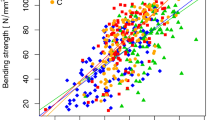Abstract
To achieve a high economic yield in the wood industry it is important to control the grading procedures and to know the quality distribution in different steps. Scots pine (Pinus sylvestris) timber from Sweden has been compared regarding quality variations in the chain log-board-blank caused by biological properties and subjective grading procedures. This study describes the quality distributions in the treatment of trees from harvesting throughout sawing and to the user's judgements, the correlation between the grading procedures in various steps, and the yield in all classes based upon the customer's opinion. The results emphasise that current classification system is very hazardous and seems not be in concordance with the customers' demand. The subjective and visual grading procedures are not sufficiently effective to predict the properties. Three main needs must be satisfied in order to reduce the costs for poor quality; knowledge about the biological variations, new equipment for grading and knowledge about the customers' needs and behaviours
Zusammenfassung
Für die Produktivität in der Holzindustrie ist es von hoher Bedeutung, die Sortiervorgänge zu kontrollieren und die Streuung der Qualitätszuweisungen bei den einzelnen Schritten zu kennen. Am Beispiel von Kiefern-Schnittholz (Pinus sylvestris) wurde innerhalb der Kette Rundholz-Schnittholz-Endprodukt die Streuung der Qualität untersucht, die sowohl durch die biologischen Eigenschaften als auch durch die subjektive, Beurteilung verursacht sind. Beschrieben wird die Qualitätsstreuung sowohl bei der Auswahl des Rundholzes im Zusammenhang mit der Ernte, beim Schnittholz und bei der Beurteilung durch den Endnutzer. Untersucht wird die Beziehung zwischen den Gütesortierungen in den einzelnen Verarbeitungsschritten und der Beurteilung der jeweiligen Ausbeute in den einzelnen Klassen durch den Verbraucher. Das Ergebnis führt, zu den Schluß, daß das gängige Sortierverfahren sehr zufallsbedingt ist und wenig mit den Anforderungen der Verbraucher übereinstimmt. Die subjektiven und visuellen Verfahren erscheinen nicht ausreichend, um die geforderten Eigenschaften zu gewährleisten. Drei Hauptpunkte müssen verbessert werden, um die Kosten auf-grund mangelnder Qualität zu reduzieren: die Kenntnis über die natürliche (biologische) Streuung, neue Sortierungsverfahren und die Kenntnisse über Anforderungen und Verhalten der Verbraucher.
Similar content being viewed by others
References
Anon: Guiding Principles for Grading of Swedish Sawn Timer 1982. Association of Swedish Sawmill Men, 4th ed., Stockholm
Blomqvist, H.; Nylinder, M. 1988: Relation between geometry, yield and quality for sawlogs of pine. Report no 205. (In Swedish), The Swedish University of Agricultural Sciences, Department of Forest Products
Chalmers, T. C. 1981: The clinical trail. Milbank Mem Fund Q, 59:324–339
Fienberg, S. E., 1976: The Analysis of Cross-Classified Categorical Data. The MIT Press
Grönlund, U. 1992: Quality variations in the chain log-board-blank caused by biological properties and subjective grading procedures. Licentiate Thesis 1992: 20L. Division of Quality of Technology & Statistics, Luleå University of Technology, Sweden
Hagman, P. O. G. 1992: Automatic quality sorting of Norway Spruce logs with Gamma Ray Log Scanner. To appear in Scandinavian Journal of Forest Research
Månsson, M. 1991: Experiences from Modern Gamma Ray Log Scanners in Sawmilling Operation. Proceeding, 4th International Conference on Scanning Technology in Wood Industry. Oct 28–29, 1991. Burlingame CA, U.S.A.
Nylinder, P. 1959: Views on the quality of production. (In Swedish). The Swedish University of Agricultural Sciences, Department of Forest Products
Orvér, M. 1970: Grading of Scots pine saw timber using objectively measurable factors. Report no R 65. (In Swedish). The Swedish University of Agricultural Sciences, Department of Forest Products
Pearson, K. 1904: On the Theory of Contingency and Its Relation to Association and Normal Correlation. Drapers' Co. Memoirs. Biometric, series No 1, London
Somers, R. H. 1962: A new asymmetric measure of association for ordinal variables. Amer Sociological Rev., 27:799–811
Weslien, H. 1983: Value grading of saw timber using objectively measurable factors. Report no 140. (In Swedish). The Swedish University of Agricultural Sciences, Department of Forest Products
Yerushalmy, J. 1955: Reliability of chest radiography in the diagnosis of pulmonary lesions. American Journal of Surgery 89:231–240
Author information
Authors and Affiliations
Rights and permissions
About this article
Cite this article
Grönlund, U. Quality variations in the chain log-board-blank. Holz als Roh-und Werkstoff 52, 57–62 (1994). https://doi.org/10.1007/BF02615021
Issue Date:
DOI: https://doi.org/10.1007/BF02615021




